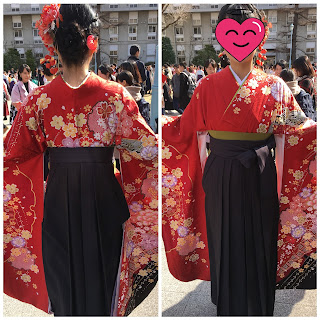 |
| Front and back pictures of a hakama worn on graduation day |
Yesterday was graduation day at my university and apart from a few wearing suits and traditional Korean dress, the vast majority of female students wore the traditional Japanese
hakama (袴). Although originally worn by men, today the male students almost always wear suits. The only time you would see a man wearing a
hakama in Japan today would perhaps be a sumo wrestler outside the ring, especially on formal occasions, a member of a martial arts club, like Japanese archery, or someone at the coming of age ceremony (
seijin-shiki).
Hakama have been described as "Japanese-style trousers" (since some have divided legs) though most of the
hakama worn at the graduation ceremony were the undivided skirt type.
Hakama are worn high, tied just below the chest, over a kimono (
hakama-shita). The picture shows a kimono with long sleeves (
furisode), typically worn by unmarried women in Japan, though not all sleeves are quite this long.
Typically, students will wake up very early on graduation day for their appointment at the beauty salon where it can take hours to get properly dressed and have their hair and make-up done. The linkage with education goes back to the Meiji period when students wore
hakama as their school uniform.
Here you can see a 1907 picture of Umeko Tsuda, a pioneer of women's education in Japan, with her students dressed in
hakama. In the evening students will change from their tight-fitting rather uncomfortable
hakama to modern Western dress and many will hold a
shaonkai (thank-you party) for their teacher. The concept of
on - indebtness - and repaying
on is, like its sister
giri, a key concept
in understanding Japanese society. See again Ruth Benedict's
The Chrysanthemum and the Sword (Chapter 5: Debtor to the Ages and the World).
